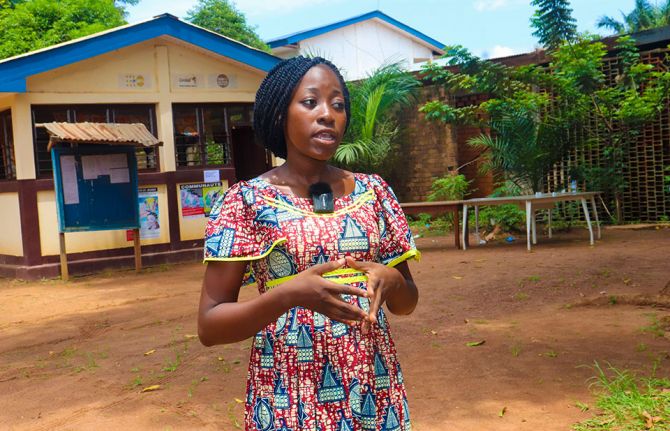
Feature Story
Education sector: Getting to grips with an HIV monitoring and evaluation framework
23 November 2009
23 November 2009 23 November 2009Credit: UNAIDS/L. Taylor
The education sector plays a critical role in national responses to the HIV epidemic. However, this contribution is often poorly appreciated and understood due to limited, difficult-to-measure data and the absence of agreement on core indicators for the sector.
To assist ministries of education and their partners in measuring progress and outcomes of related efforts, a host of international experts met in London on 9-10 November to develop a monitoring and evaluation (M&E) framework for education sector responses to AIDS. This framework aims to assist ministries of education and other partners in outlining and measuring the main programme outputs and outcomes of the education sector, facilitating the development of effective, results-focused interventions.
Convened by the Partnership for Child Development (PCD) of Imperial College, on behalf of the Indicators Working Group of the UNAIDS Inter-Agency Task Team (IATT) on Education, the experts attending the meeting included individuals with significant expertise in M&E, in education sector responses and with a great deal of programme experience. Programme managers from Southern Africa, Latin America and the Caribbean, and South and South-East Asia attended.
Getting things right in the education sector’s monitoring and evaluation of its response to HIV is essential if it is to provide a ‘social vaccine’ to the epidemic, offering knowledge and personal skills which can prevent HIV.
Michael Beasley, director of Partnership for Child Development at Imperial College London
The meeting built on a review of existing indicators used to monitor education sector HIV responses undertaken by PCD on behalf of the UNAIDS IATT on Education Indicators Working Group. It also contributed to an effort underway by a wide range of partners associated with the FRESH (Focusing Resources on Effective School Health) Initiative to develop an M&E framework for school-based health and nutrition and HIV prevention interventions.
As well as reaching agreement on appropriate priorities for the monitoring and evaluation of the sector’s work, the meeting also achieved consensus on prioritising indicators that could be used.
Indicators examined included those helping the education sector address the following questions:
1. Within the context of a national AIDS response, is there a response in the education sector that is guided and enabled by policy, strategy and resources?
2. Is HIV, reproductive and sexual health education a timetabled subject delivered in schools? Is it mandatory and assessed? Are HIV-related life skills delivered through co-curricular means?
3. Are educators receiving pre-service and in-service training about HIV (for themselves) and about teaching HIV to students?
4. Is the education sector facilitating testing, treatment, care and support services for learners and educators? Are measures in place to make schools safe and protective environments?
In addition to indicators to measure these short-term outcomes, the group also considered intermediate outcomes such as knowledge about HIV and those of a long-term nature such as age of sexual debut.
The draft M&E framework and proposed indicators will be presented to the UNAIDS IATT on Education at its meeting on 2-4 December 2009 in Berlin, Germany. Anticipated next steps include field-testing the new proposed indicators, and refining the definitions of existing ones. This will be taken forward by members of the IATT on Education’s Indicators Working Group in early 2010, in consultation with ministries of education and national partners.
According to Michael Beasley, director of Partnership for Child Development at Imperial College, “Getting things right in the education sector’s monitoring and evaluation of its response to HIV is essential if it is to provide a ‘social vaccine’ to the epidemic, offering knowledge and personal skills which can prevent HIV.” He added, “It is estimated that young people who fail to complete a basic education are more than twice as likely to become infected as those who do. Education also reduces the vulnerability of girls, and each year of schooling offers greater protective benefits.”
Empowering young people to protect themselves from HIV is one of the nine priority areas for UNAIDS and its Cosponsors under the Joint Action for Results: UNAIDS Outcome Framework 2009-2011.
Formed in 2002, the UNAIDS IATT on Education is convened by UNESCO and brings together UNAIDS Cosponsors and other multilateral organisations, bilateral agencies, private donors and civil society partners with the purpose of accelerating and improving a coordinated and harmonised education sector response to HIV.
Education sector: Getting to grips with an HIV mo
Cosponsors:
Feature stories:
China’s vocational schools play a key role in AIDS education (16 October 2009)
UNAIDS Task Team develops effective tools to help young people tackle HIV (05 June 2009)
HIV response and the education sector: UNESCO Best practice series (04 May 2009)
Publications:
A review conducted on behalf of the UNAIDS IATT on Education Indicators Working Group (pdf, 508 Kb.)
A Strategic Approach: HIV & AIDS and Education UNAIDS IATT on Education, 2008 (pdf, 2.44 Mb.)
Toolkit for Mainstreaming HIV and AIDS in the Education Sector: Guidelines for Development Cooperation Agencies. (UNAIDS IATT on Education, 2008) (pdf, 1 Mb.)



